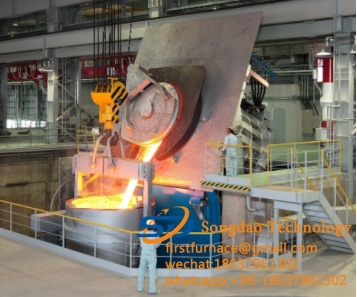- 26
- May
How to improve the temperature resistance of induction melting furnace lining? After reading it, I have benefited a lot!
How to improve the temperature resistance of induction melting furnace lining? After reading it, I have benefited a lot!

The high temperature performance of the furnace lining mainly depends on the physical, chemical properties and mineral composition of the refractory materials used. Under the premise of selecting the raw and auxiliary materials, the sintering process is the key to obtain a good microstructure of the furnace lining to give full play to its high temperature resistance. Process. The degree of densification of lining sintering is related to the chemical composition, particle size ratio, sintering process and sintering temperature of the refractory materials.
Furnace building process
1. Remove the mica paper when building the furnace.
2. The crystal quartz sand for furnace construction is treated as follows:
(1) Hand selection: mainly remove lumps and other impurities;
(2) Magnetic separation: magnetic impurities must be completely removed;
3. Dry ramming material: it must be slowly dried, the drying temperature is 200℃-300℃, and the heat preservation is more than 4 hours.
4. The selection of binder for intermediate frequency electric furnace: use boric anhydride (B2O3) instead of boric acid (H3BO3) as the binder, and the addition amount is 1.1%-1.5%.
Selection and proportion of furnace building materials:
1. Selection of furnace materials: It should be noted that not all quartz sands with SiO2≥99% can be used as induction furnace lining materials. The important thing is the size of the quartz crystal grains. The coarser the crystal grains, the fewer lattice defects, the better. (For example, crystal quartz sand SiO2 has high purity, white and transparent appearance.) The larger the furnace capacity, the higher the requirements for crystal grains.
2. Proportion: The ratio of quartz sand for furnace lining: 6-8 mesh 10%-15%, 10-20 mesh 25%-30%, 20-40 mesh 25%-30%, 270 mesh 25%-30%.
Sintering process and sintering temperature:
1. The knotting of the lining: the knotting quality of the lining is directly related to the sintering quality. When knotting, the sand particle size distribution is uniform and no segregation occurs. The knotted sand layer has a high density, and the probability of cracking after sintering is reduced, which is beneficial to improve the service life of the induction furnace lining.
2. Knotted furnace bottom: The thickness of the furnace bottom is about 280mm, and the sand is filled in four times to prevent uneven density everywhere when manual knotting, and the furnace lining after baking and sintering is not dense. Therefore, the thickness of the feed must be strictly controlled. Generally, the thickness of the sand filling is not more than 100mm/each time, and the furnace wall is controlled within 60mm. Multiple people are divided into shifts, 4-6 people per shift, and 30 minutes for each knot to replace, around the furnace Rotate slowly and apply evenly to avoid uneven density.
3. Knotting furnace wall: the thickness of the furnace lining is 110-120mm, adding dry knotting material in batches, the cloth is uniform, the thickness of the filler is not more than 60 mm, and the knotting is 15 minutes (manually knotting) until it is level with the upper edge of the induction ring together. The crucible mold is not taken out after the knotting is completed, and it functions as induction heating during drying and sintering.
4. Baking and sintering specifications: In order to obtain the three-layer structure of the furnace lining, the baking and sintering process can be roughly divided into three stages:
5. Baking stage: heating the crucible mold to 600°C at the speed of 25°C/h and 50°C/h respectively, and keep it for 4h, the purpose is to completely remove the moisture in the furnace lining.
6. Semi-sintering stage: heating at 50°C/h to 900°C, holding for 3h, heating at 100°C/h to 1200°C, holding for 3h, the heating rate must be controlled to prevent cracks.
7. Complete sintering stage: During high-temperature sintering, the sintered structure of the intermediate frequency electric furnace crucible is the basis for improving its service life. The sintering temperature is different, the thickness of the sintering layer is insufficient, and the service life is significantly reduced.
